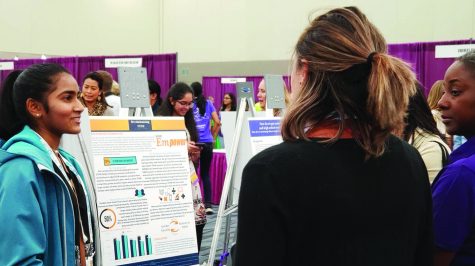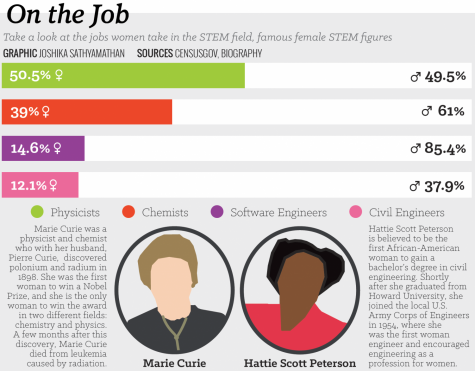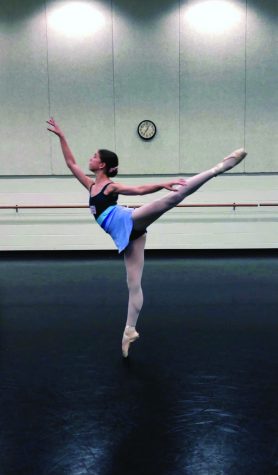Women of STEM
CHS female students recognize prejudices regarding their role in STEM community, stress female participation in field
Since the acronym STEM (Science, Technology, Engineering, Mathematics) was coined in 2001, the field has been primarily male-dominated. However, as the STEM field continues to expand and grow, more and more females are starting to get involved with the community. Still, according to Western Governors University, currently in the United States only 15% of direct science and engineering jobs are held by women.
Geetika Chitturi, president of the Carmel Society of Women Engineers Next (SWENext) Club, the CHS chapter of the world’s largest organization for women in engineering, and sophomore, said it is important for females to have a role in the STEM field because it increases female representation.
“The more women join STEM fields, the more equality we will get because the numbers would definitively prove that gender plays no role in determining the capability of someone to be successful in STEM,” Chitturi said.
Girija Chavali, student leader of the Carmel Girls Who Code Club and junior, said she concurred with Chitturi’s statement. She added it is important now more than ever to encourage females to take up STEM professions, especially in technology and engineering. She said STEM was important as it could be connected to every field, and, hence, all people, not only females, should look into learning something based in STEM.

Geetika Chitturi, student leader of Carmel SWENext club and sophomore, presents about women in engineering at an event. This year due to COVID-19 the club is meeting only over zoom and events like the one in the picture are not taking place.
Submitted Photo: Geetika Chitturi
Sarah Fernando, member of Carmel Girls Who Code Club and junior, said the industry has evolved to incorporate female employees, but there is still a lot to be done to normalize their participation in STEM.
Fernando said, “Women are equal or sometimes even better than their male counterparts and should not be discriminated against. There needs to be real change through efforts to teach young girls about STEM, expose them to the field and make them aware of the prejudice that exists in order to make a real difference.”
But prejudice against females in STEM roles that were traditionally male have persisted for a long time. According to a report by Pew Research Center, 50% of women in traditionally male jobs have been on the receiving end of discrimination and sexual harassment. This is not just limited to the workplace, as prejudice persists even in the most common spaces.
Chitturi said she has experienced prejudice despite only being a high school student.
“Oftentimes, when I am in mostly male settings with people I do not know well, which occurs frequently at STEM events or in STEM classes, I and my ideas tend to be ignored and my ability to perform is automatically discounted due to me being a female,” Chitturi said.
Chavali said she faced prejudice for being in LEGORobotics in eighth grade. She said when she was in a computer class, a boy in the same class had assumed that she did not know how to use a computer and was trying to teach her how to open new tabs on the laptop.
Chavali said prejudice is also present in the physical aspect of being one of two girls in her AP Computer Science class, and it was unfortunate that more girls were not in classes such as these.
Industrial technology teacher Laura Erli also recounted her experiences with prejudices for being a female in a male-dominated field. Erli said when she was taking construction classes in high school her teacher commented that those who could not lift the wood delivered for the class should not have been there. Erli also talked about the time she was looking for a new job as the school she was teaching at was closing.
She said, “I had one interview that as I walked down the hall toward the engineering department, I clearly heard one of the gentlemen from the department mutter, ‘It’s a girl.’ I clearly was wasting my time at that location. It was to my ultimate benefit since eventually I got a call from CHS and am now enjoying my job more than I could have imagined.”

Girija Chavali, student leader of Girls Who Code club and junior, codes from the comfort of her own home. Besides meeting through zoom calls the club is very independent this year, members work on a software and code at their own pace.
Photo: Luke Miller
According to Erli, there is no point in limiting progress simply because of a person’s gender.
“I have always believed that everyone has the right to study and work in a field that they love. Gender, race, age or religion should not play a factor in if you can do something or not,” Erli said.
Erli, who majored in technology in college, said her major was male-dominated and she was the only girl taking construction and manufacturing courses in high school. According to Erli, this kind of representation is important because women are often not represented in this field and young females have something to look up to, seeing not only males getting involved in the STEM community.
Fernando said despite the prejudice women in the STEM field face, she wants to show all women that the STEM field is not just for men and all are welcome and that they can make a change if they really want to.
“Even if you’re not female, I encourage you to do what you can to make the STEM field a more inclusive place that females are not afraid to get into. Educate yourself on the discrimination and prejudice women face in the workplace and do something to make a change.” Fernando said.
Chitturi said she believes women are able to find more opportunities if they are able to overcome the prejudice they face because their talents will be recognized.
“I think it is important that I have a role in this field because it increases female representation in STEM,” she said. “The more women (that) join STEM fields, the more equality we will get because the numbers would definitively prove that gender plays no role in determining the capability of someone to be successful in STEM. More women in STEM also increases the support system for women in STEM which is vital to many women as a source of comfort and compassion in a male-dominated field where they often feel that they are not listened to or understood.”
According to Western Governors University, young females often do not see many women going into the STEM field, so they have fewer role models and examples to follow. With more females already getting involved in STEM, the field is only to expand further.
As the number of females studying STEM in schools and pursuing careers in this field, the field is evolving and is working towards the normalization of female participation in STEM.
According to Chitturi, “Products and services directed towards a female market that have been designed by men in the past are beginning to shift into the control of women in the industry who are more familiar with what female consumers are looking for.”
As the workplace grows and evolves to accommodate more women, the number of women in STEM jobs has also increased exponentially.
According to LinkedIn, more women have entered STEM jobs in the past 40 years than ever seen before. The article stated that male-dominated fields such as construction, public safety, design and others saw the most increase in female representation. Jobs such as test development engineer, automotive salesperson, and architect saw increases of 243%, 154% and 127% respectively.
Though the gap is close to being bridged, Chivali said there still remains a lot to do for women to be able to comfortably work in STEM fields and take even more pride in their jobs.
Chavali said being in a STEM field as a woman was a matter of confidence, of unlearning the fear of it and starting to stop associating coding or other STEM jobs with males. She said, “There are a lot of women who want to do coding and given the right resources, she could flourish in that field, but because of societal standards of what a woman is supposed to, even if the gender gap is getting smaller, there is still a lot to improve in creating a support system that helps women do what they actually want to do.”






